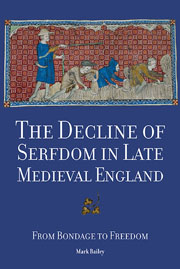Book contents
- Frontmatter
- Contents
- List of Maps
- List of Graphs
- List of Tables
- Acknowledgements
- Abbreviations
- Part I The Decline of Serfdom: Questions and Approaches
- Part II Case Studies
- 5 Reassessing the Decline of Serfdom: Methods and Sources
- 6 Walsham-le-Willows
- 7 Merton College, Oxford
- 8 Aldham
- 9 Tingewick and Upper Heyford
- 10 The Abbot of Bury St Edmunds
- 11 The Dukes of Norfolk
- 12 Miscellaneous manors
- Part III Conclusions
- Appendix: List of original sources used in this study
- Chronology
- Bibliography
- Index
11 - The Dukes of Norfolk
from Part II - Case Studies
Published online by Cambridge University Press: 05 March 2014
- Frontmatter
- Contents
- List of Maps
- List of Graphs
- List of Tables
- Acknowledgements
- Abbreviations
- Part I The Decline of Serfdom: Questions and Approaches
- Part II Case Studies
- 5 Reassessing the Decline of Serfdom: Methods and Sources
- 6 Walsham-le-Willows
- 7 Merton College, Oxford
- 8 Aldham
- 9 Tingewick and Upper Heyford
- 10 The Abbot of Bury St Edmunds
- 11 The Dukes of Norfolk
- 12 Miscellaneous manors
- Part III Conclusions
- Appendix: List of original sources used in this study
- Chronology
- Bibliography
- Index
Summary
The Bigod earls of Norfolk acquired extensive lands within East Anglia soon after the Norman Conquest, which by the thirteenth century were administered from their splendid baronial seat at Framlingham (Suffolk). In the fourteenth century the title eventually passed to the Mowbray family, and in 1397 earl Thomas Mowbray was elevated to become the first duke of Norfolk. The last Mowbray duke, John, died in 1476, and in 1483 the title and lands were bestowed upon the Howard family.
This case study is based upon the substantial archive relating to three manors on this estate, and also upon F.G. Davenport's study of a fourth, Forncett St Mary (Norfolk). Forncett lies twelve miles south of Norwich, high on the clay interfluves. Cratfield, Dunningworth and Staverton were small- to medium-sized manors in east Suffolk. Dunningworth and Staverton were located near the coast, the former at the neck of the river Alde near what is now Snape bridge while the latter is further downriver, off Butley creek. Staverton manor extended across the settlements of Eyke, Wantisden and Bromeswell. Cratfield is a short distance north of Framlingham.
The choice of this estate for a case study is partly a function of the quality of its archive, but it is also due to the reputation of the sixteenth-century Howard dukes for their aggressive and exploitative management of their bondmen.
- Type
- Chapter
- Information
- The Decline of Serfdom in Late Medieval EnglandFrom Bondage to Freedom, pp. 198 - 239Publisher: Boydell & BrewerPrint publication year: 2014

